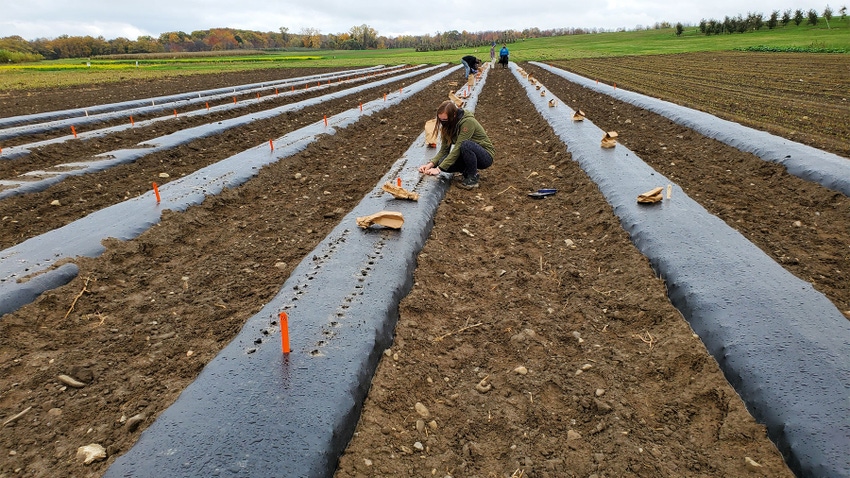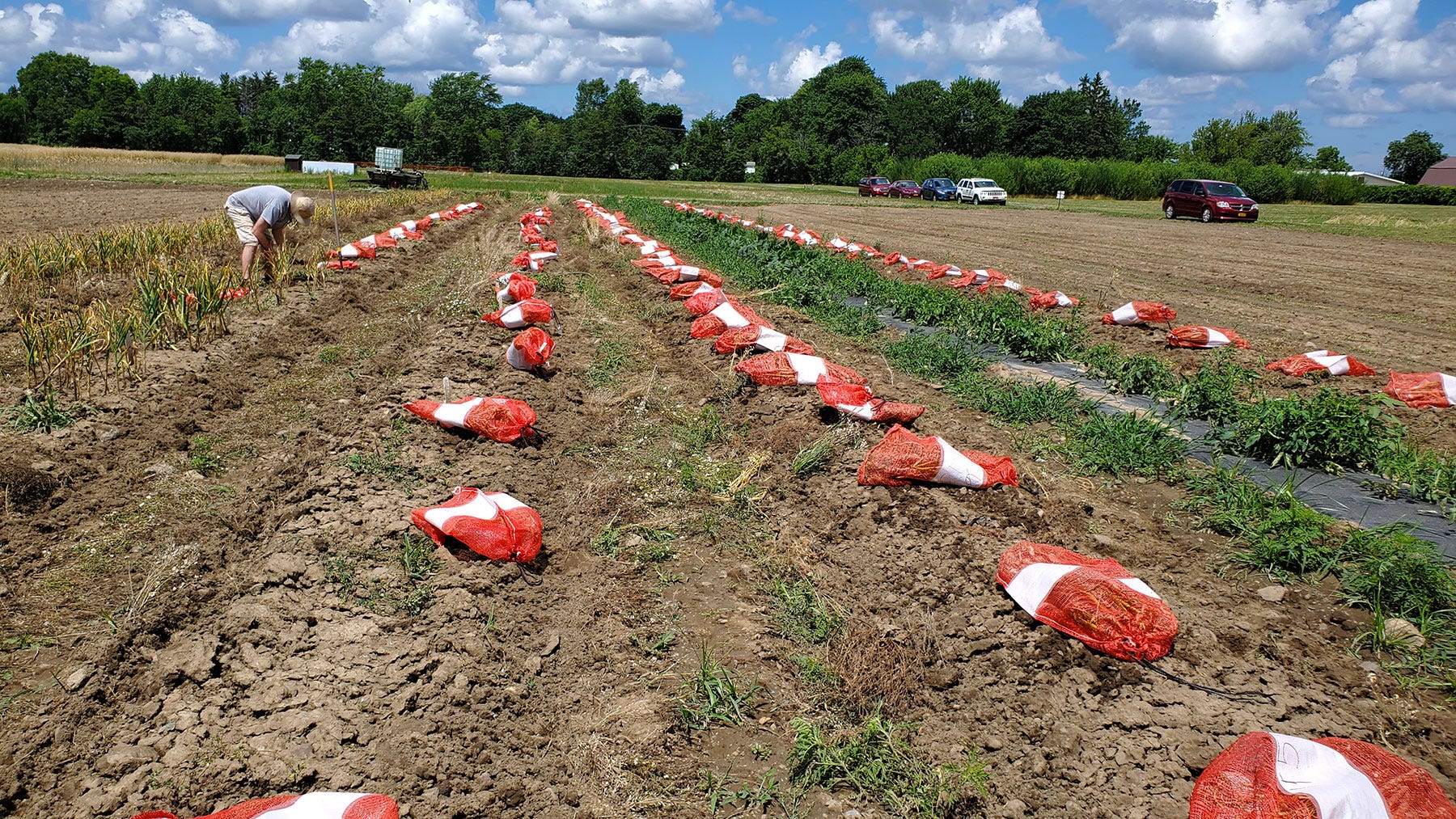July 28, 2023

New York state is the fifth-largest producer of garlic in the U.S., with a crop estimated to add $20 million to New York’s economy annually.
But since garlic is vegetatively propagated though its seed cloves, seedborne diseases and pests can lead to severe crop and economic damage, says Frank Hay, plant pathologist with Cornell AgriTech.
With a grant from the New York Farm Viability Institute, Hay tested hot water treatment combined with different products as a seed dip for the management of bloat nematode in garlic cloves.
In high numbers, bloat nematode can destroy garlic crops. For example, infested seed caused an outbreak in Northeastern states in 2010. Growers responded by sourcing clean seed, moving production to new ground and instituting a four-year allium-free fallow period on the affected ground to reduce the risk of BN.
“Bloat nematode is currently only a sporadic problem in New York,” Hay says. “Still, growers are wary of this pest and often inquire as to seed treatments that might reduce the risk of importing diseased seed onto farms.”
Large-scale garlic growers have historically heat-treated seeds by immersion in hot water at 38 degrees C (100.4 degrees F) for 30 minutes, then immersing the cloves in water at 49 degrees C (120.2 degrees F) for 20 minutes, and then a final immersion in water at 18 degrees C (64.4 degrees F) for 10 minutes to cool the cloves.
Generally, the volume of cloves was adjusted to be less than 25% of the volume of water in the treatment tank to prevent large fluctuations in temperature when the cloves were added.
Formaldehyde was often used in the hottest treatment to enhance the biocidal effect on BN. In addition, the fungicide benomyl was used in the cool-down treatment to reduce risk of fungal development on the wet cloves.
These cloves were then dried at room temperature and planted within a few days of treatment.
Hot water treatment fell out of favor with larger-scale growers as disease-free seed came available. And formaldehyde and benomyl are no longer available because of safety concerns.
Renewed interest in hot water treatment
Sporadic outbreaks of BN on small-scale garlic operations have prompted renewed interest in hot water treatment to reduce the risk of bloat nematode.
Hay and colleagues successfully developed a heat treatment suitable for smaller-scale growers and evaluated it for crop safety and efficacy against bloat nematode. Equipment consisted of two circulating immersion heaters and three domestic cooler bins that could treat about 20 pounds of garlic seed cloves at one time.
One of the concerns growers have for adopting heat treatment is the narrow temperature range needed for successful treatment. Temperatures of 49 degrees C for 20 minutes have been found to be the best compromise in terms of being lethal to the nematode, while having minimal negative effects on seed viability.
Anything lower allows greater survival of the nematode, while anything higher can be detrimental to the seed.
Testing for safety
Hay tested five varieties of garlic and two size ranges of uninfested cloves. These cloves, in mesh onion bags, were prewarmed and treated at 48 degrees C, 49 degrees C and 50 degrees C for 20 minutes, followed by the standard post-treatment cool down.
Foam board was used to keep the cloves immersed and to help maintain temperature. The treated cloves were planted and grown through the season.
The 50-degree C treatment for 20 minutes was damaging to seed emergence, total bulb yield per plot and individual bulb weight in comparison to the untreated control. The 49-degree C treatment had no effect on seed emergence, although it showed a slight but acceptable reduction in total bulb yield and individual bulb weight in comparison to the untreated group. The 48-degree C treatment showed similar seed emergence, total yield and individual bulb weight compared to the untreated group.
“Our results confirmed that there was a fine temperature margin between attaining the necessary temperature to kill BN while maintaining seed viability and performance,” Hay says. “Therefore, if growers are to utilize hot water treatment, they need to invest in equipment that can maintain precise temperature. Any efforts with fluctuating temperatures either do not maintain a sufficient duration of temperature necessary to kill the nematode, or have temperatures too high that adversely affect the seed.”

MAJOR CROP: Garlic is a significant niche crop for growers in New York state, the fifth-largest producer of garlic in the U.S.
Hay treated seed graded into small and large sizes to determine if the viability and performance of smaller seed was affected by temperature to a greater extent than larger seed.
“Grading by seed size for treatment made no difference in the magnitude of the difference in bulb yield, and individual bulb weight between the untreated seed and seed heat-treated at 48, 49 and 50 degrees C,” he explains. “As expected, the small seed had similar emergence to the large seed, but with lower total yield and individual bulb weights than larger seed.”
Dipping trials
Hay then tested cloves harvested from a trial area infested with bloat nematode by adding nematicidal products in a slightly longer cooling dip (18 degrees C for 20 minutes). The nematicidal products were two formulations of Majestene, containing the heat-killed bacterium Burkholderia cepacia at 1% volume per volume; a general household bleach disinfectant at 20% volume per volume; Trilogy containing neem oil at 1% volume per volume; and an insecticidal product, AgriMek, containing abamectin at 0.25 milliliters.
AgriMek is not registered for bloat nematode, but it was used as a control as it has shown some efficacy against it in Canadian trials.

HEAT TREATMENT: This experimental garlic treatment apparatus built for Hay’s project consisted of three domestic coolers with two immersion circulating heaters. It cost about $3,500.
After dipping, the cloves were stored at room temperature for one week before assessment.
“Results demonstrated that heat treatment considerably reduced but did not eradicate bloat nematode from the seed in comparison to non-heat-treated seed,” Hay says. “Unfortunately, the addition of products to the cooling dip provided no further reduction in BN numbers in comparison to heat treatment alone.”
What’s the best strategy?
“Heat treatment substantially reduced but did not eradicate BN, and the addition of products to the 49-degree C stage did not provide any further level of control in comparison to heat treatment alone, and often left populations sufficiently high enough to cause significant damage,” Hay says. “Likewise, dipping in the nematicidal products without heat treatment was ineffective at reducing bloat nematode.
“This research demonstrated that careful use of hot water treatment had minimal impact on garlic seed viability and crop yield. However, while heat treatment alone substantially reduced BN in seed, it was insufficient to completely eradicate BN. The most effective strategy for minimizing the introduction of BN on-farm remains sourcing seed from reputable sellers, or growers producing their own seed.”
For more information, email Hay at [email protected].
Dunn writes from her farm in Mannsville, N.Y.
About the Author(s)
You May Also Like




